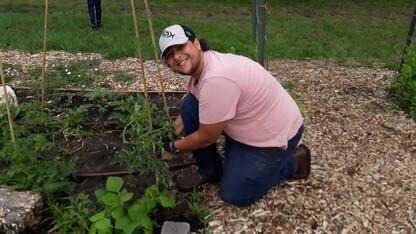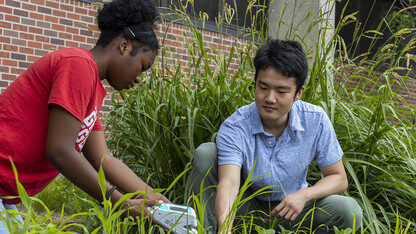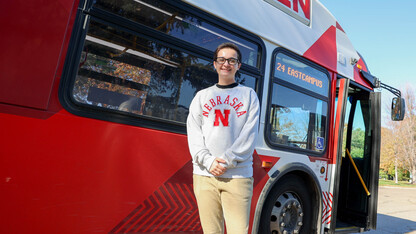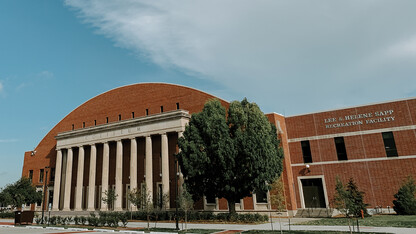
Ava Britton's trip to Canada was no wild goose chase — it was more a wild duck hunt, and a successful one.
The first-year master's student in the School of Natural Resources had planned to come to Nebraska in fall 2024 to study two-tier duck hunting regulations under the guidance of professors Chris Chizinski and Mark Vrtiska. Before that could happen, the professors suggested she take a graduate field course in the Prairie Pothole Region of Canada and the northern United States. Britton had studied songbirds and falcons as an undergraduate in Arizona but hesitated to apply to the Delta Waterfowl Foundation to take a waterfowl course with further-along graduate students.
"Initially, I was intimidated," she said. "And I asked Chris and Mark, 'Are you sure you think it's a good idea that I go, having not even started my program yet?' And they were like, 'Yeah, definitely. Just immerse yourself in it and just have the experience.' And I definitely agree with them that it was, honestly, great timing for me because I feel like it laid a good foundation for me to go off of now, starting the school year."
The 12 graduate students selected for the course started out in Bismarck, North Dakota, where they searched for nests and met with wildfowl professionals. Students used a handheld tool called an egg candler, to look into the eggs, gauge development and predict when the ducklings would hatch. Wildfowl specialists use such techniques to track nest success and bird populations.
The students next drove to the Delta Marsh in Manitoba, a Canadian province, the main conservation area of the Delta Waterfowl Foundation. They met more wildfowl professionals there and learned more about the importance of the Prairie Pothole Region in wildfowl conservation. The wetland region is sometimes called the “duck factory” in North America because most ducks breed and feed there before migrating south for the winter. It covers about 700,000 square kilometers, or about 270,271 square miles, mainly in North Dakota, South Dakota, Minnesota and the bordering Canadian provinces.

Britton said traveling great distances by vehicle was probably the only drawback of the experience, but the travel was broken up nicely by enjoyable activities like searching for nests, banding ducks and networking with professionals and other graduate students. The natural resources management major had hunted ducks with her father a couple of times in high school, but holding a live duck for the first time was exciting.
As part of the course, she attached a band to one leg of canvasback ducks and attached a nose saddle with a matching identification number to their bill. The numbers on the saddle are more visible at a distance, allowing easier identification and tracking than just leg bands. Britton had banded the legs of birds before but never attached a nose saddle.
"I was intimidated by doing that," she said. “"I was just worried about it because you have to put a pin through their beak, and I was pretty nervous. It was definitely a learning experience, but I successfully did it, which is good.”
The ducks didn’t bite her, she said, but tried to get away, clearly not up for a nose piercing. It was this type of experience that Britton said students can’t get in a traditional classroom setting and yet complement learning well.

She had never visited the Prairie Pothole Region before and said viewing it firsthand also impressed her.
"Being there and seeing all of the little potholes and really actually seeing all of the nesting ducks was incredible, and it definitely doesn't compare to just reading about it," she said.
She identified her biggest takeaway from the course as gaining the personal, hands-on experience of understanding the scale and complexity of waterfowl conservation. She learned about the main organizations involved in waterfowl conservation and their work and dedication in research, habitat restoration and policy.
She had been interested in research and habitat restoration before the course but had less exposure to policy work, she said. During the course, Britton took the opportunity to ask people from the U.S. Fish and Wildlife Service and state agencies why they went into policy work and how they came to their current position. She said most of them told her they basically fell into the policy work. Although she had not considered working in policy before, she said she definitely would be interested in it in the future.
Besides networking with the professionals, Britton said meeting other graduate students and bouncing ideas off them ended up being one of the most valuable parts of the class.
"We all had such unique projects and unique backgrounds, and I think that that was extremely valuable," she said. "We all had the opportunity to present on our own research, and that was really awesome because I was able to ask them a lot of questions and get feedback going into my first year."
The course confirmed her decision to work with waterfowl and the human dimensions of natural resource management.
"It definitely reinforced that I'm on the path that I want to be on in conservation," she said.







